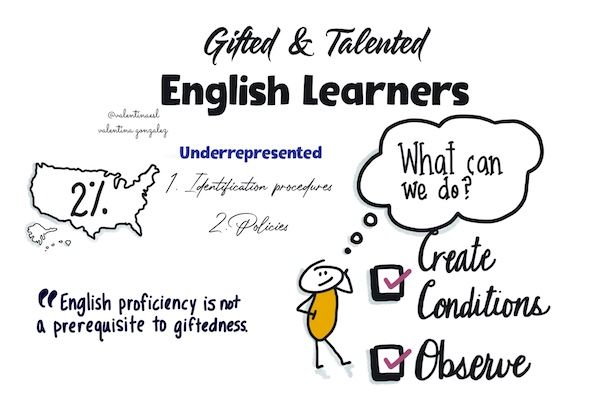How Do We Identify Gifted English Learners?
A MiddleWeb Blog

If you’re a glass-half-full person like I am, you might consider all of your students as gifts and gifted in some way. I have always taken that approach with my own children and each of my students as well.
All our students come to us with strengths and skills that they are highly capable of applying. And it’s also true that some may come with an extra helping.
Many times it’s parents that first realize that their child may be “gifted.” Think about that for a moment. Imagine a family that notices a child may have unusual gifts. Family members may not speak English well yet. Perhaps they recently arrived.
Maybe in their home country the norm was not to approach the school or teacher about instruction. Or maybe they had their own bad experiences with school. How likely is this family to come to school and let us know that they think their child might qualify for the gifted program?
NPR reports that across the USA only 2% of ELs are in gifted programs, as opposed to 7.3% of non-ELs. The cause of such a gap? While a number of reasons exist for the under-representation of ELs in gifted programs, it has been determined that identification procedures and policies are two of them.
Additionally, a survey by the Education Week Research Center reported that gifted and talented programs are failing to reach many populations, including ELs.

“Students, children, or youth who give evidence of high achievement capability in areas such as intellectual, creative, artistic, or leadership capacity, or in specific academic fields, and who need services and activities not ordinarily provided by the school in order to fully develop those capabilities.” [Title IX, Part A, Definition 22. (2002)]
— many states follow their own definition. Furthermore, each state has its own screening criteria and programs for students that qualify. Some states are highly supportive of identifying and serving ELs while others are just not there yet.

I encourage you to take a look at what your state has to offer. This link will take you to The National Association for Gifted Children (NAGC) where you will find a list of all the states and numerous other resources.
In her article on the Seidlitz Education Blog, Macry Voss shares that though it may be difficult to identify ELs as gifted, it’s not impossible. She says that as educators we only need to do two things: create conditions and observe! Sounds easy enough. Let’s take a closer look.
Creating Conditions
Knowing that students will show their gifts in various ways and that the evidence may not come through in graded classroom work, local or state assessments or other typical means will help with identifying ELs who may qualify for gifted and talented services. If a student is working in isolation, working on watered down curriculum, or working on tasks that require little thought, you are not creating the conditions that will reveal the gifted potential your EL holds.
Here are a few ways teachers can increase engagement and motivation and thereby gain insight into what your EL may be capable of achieving:
▢ Choice in free reading
▢ Choice in writing topics
▢ Product oriented work
▢ Artistic representations
▢ Collaborative learning
▢ Portfolio samples
Observing
Knowing what to look for when trying to determine if an EL may qualify for gifted services is key to possible entry. One of the biggest challenges for educators in this situation is a possible communication barrier. If you are not able to speak the same language as your EL, it can be difficult to know what they are thinking or understanding.
It may be a struggle to assess their comprehension. It’s hard to tell if an EL is curious, has a keen sense of humor, or has a heightened sense of justice if we aren’t able to speak the same language yet. Here are a few indicators to look for as you try to determine if an EL may benefit from being screened for gifted services (including in their current primary language):
▢ Successful academic history in student’s primary language
▢ Advanced developmental history according to family interview/screening
▢ Rapidity of learning new language and/or content
▢ Ability to problem solve
▢ Reading above grade level in primary language
▢ High proficiency in mathematics
▢ Interest in honoring his/her culture
▢ Respect for cultural differences
▢ Code switching
▢ Desire to teach classmates words from his/her primary language
According to the Texas Education Agency (TEA), “access to assessment and, if needed, G/T services must be made available to all populations of the district.” But we have to remember that screening only happens when a teacher or parent notices patterns of exceptional performance in an EL and advocates for the child. This calls for educators to be closely attuned to students’ abilities. “Formal channels of communication between gifted/talented and ELL teachers and coordinators are vital to gifted/talented ELL success.” (Belin & Blank, 2008, p. 29)
In addition, TEA says that, “Students must be assessed in languages they understand or with nonverbal assessments.” It is common in many states to provide a nonverbal assessment to ELs. However many argue that this type of assessment actually works to limit or exclude ELs who excel in other areas (Belin & Blank, 2008, p.15).
Keep in Mind
English proficiency is not a prerequisite to giftedness.
A student’s ability to express themselves in English should not be a prerequisite for gifted and talented services. Do not wait until your student can communicate in English before you initiate testing. If you suspect a child may qualify, begin your state’s or district’s referral process for screening.
Looking Back & Moving Forward
It makes me sad to think back on the English learners I taught over the years who may have qualified for gifted and talented services but were not afforded the chance because of my lack of knowledge about identifying their gifts. I’m well aware now that there were a few I let slip by me.
Moving forward we can change the present and future landscape for gifted and talented ELs by helping all stakeholders know how to create conditions that allow ELs to shine and know what characteristics to look for in ELs who may qualify for gifted programs. Spend some time investigating the published work in this arena and start conversations with G&T experts in your district and community!



































Valentina,
I love your practical ideas contained in the lists in this article! They focus on what we can do! Well done, amiga!
It’s nice to have a checklist, even though most teachers have a gut instinct about gifted ELLs. I’ve had a few over the past 20 years, and it is inspiring to watch them succeed!
Thank you for providing this valuable information to educators! A related topic is bilingual (not ELs) students’ access to gifted education. In Florida, many districts have an alternative pathway to gifted ed for EL, which can be a really good first step (if they follow their own policies and procedures, which is not always the case). However, for bilingual students who do not qualify for EL programs if their English proficiency is not limited, may have, for example, a limited vocabulary in English when compared to monolingual English speakers (although they have many other important abilities). Thus, they may not perform at the level required on the intelligence test for entry into gifted ed. This is not accounted for in the test score requirement and, sometimes, in the test administrator’s considerations. When a district doesn’t complete a social history with the family either, this can be missed. So, while some districts have made good strides in alternative eligibility requirements for ELs, bilingual students who are not ELs are too often being overlooked.
Hi Valentina,
I an an English Learner (EL) Teacher in Northern Virginia with 22 years of experience. I have been saying for years that ELs have giftedness and teachers need to start advocating for students. However, content teachers believe that in order to be gifted, students need to be able to speak English.
I am a member of my school’s Equity committee and I volunteered to give a PD on Gifted ELs for the staff. I think the checklists will give teachers the means to create opportunities for EL students and then observe their giftedness shine.
I would also like to know how I might get a copy of the survey from Education Week Research Center that you mentioned in this article. Thank you for sharing this article. I nearly turned blue in the face trying to tell everyone who would listen to my claim that EL students have giftedness.